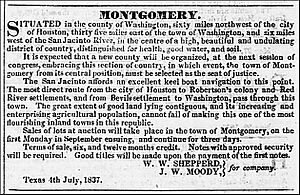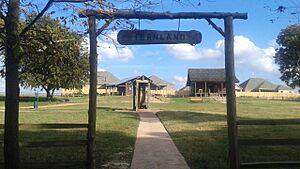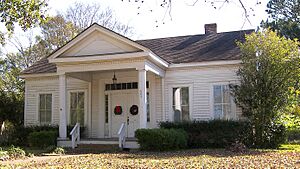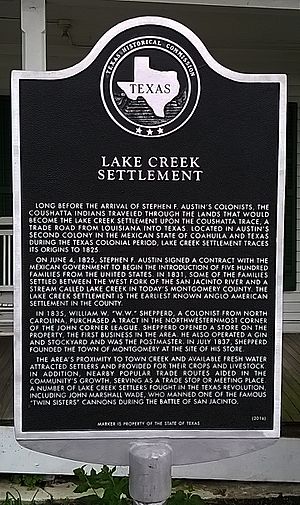Montgomery, Texas facts for kids
Quick facts for kids
Montgomery, Texas
|
|
|---|---|
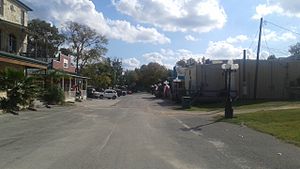
Historic Business District in Downtown Montgomery.
|
|
| Nickname(s):
Lone Star Town
|
|
| Motto(s):
Texas is Texas
|
|
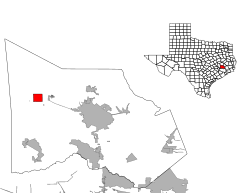
Location of Montgomery, Texas
|
|
| Country | |
| State | |
| County | Montgomery |
| Incorporated | February 26, 1848 |
| Area | |
| • Total | 5.12 sq mi (13.26 km2) |
| • Land | 5.04 sq mi (13.05 km2) |
| • Water | 0.08 sq mi (0.20 km2) |
| Elevation | 295 ft (90 m) |
| Population
(2020)
|
|
| • Total | 1,948 |
| • Density | 269.89/sq mi (104.20/km2) |
| Time zone | UTC-6 (Central (CST)) |
| • Summer (DST) | UTC-5 (CDT) |
| ZIP codes |
77316, 77356
|
| Area code(s) | 936 |
| FIPS code | 48-49128 |
| GNIS feature ID | 1382317 |
Montgomery is a small city in Montgomery County, Texas, United States. It's known as the "Lone Star Town" and has a rich history. In 2020, about 1,948 people lived there.
Contents
A Look at Montgomery's History
The city of Montgomery was founded in July 1837 by W. W. Shepperd. He bought 200 acres of land in the Lake Creek Settlement to create the town. Shepperd had already opened the first store in the area in 1835. He and his business partner, John Wyatt Moody, named the new town Montgomery.
Montgomery quickly became important. It was chosen as the first county seat for Montgomery County soon after the county was formed on December 14, 1837. This made Montgomery County the third county created during the time of the Republic of Texas. The city was officially made a city in 1848, with Judge Nathaniel Hart Davis as its first mayor.
How Did Montgomery Get Its Name?
For a long time, people thought Montgomery was named after early settlers like Andrew Montgomery. However, new information suggests a different story. It's now believed that the town and county were named after Lemuel P. Montgomery. He was a major in the U.S. Army during the Creek War.
John Wyatt Moody, one of Montgomery's founders, used to be a clerk in Montgomery County, Alabama. That county was named after Lemuel P. Montgomery. Also, Sam Houston, who was President of the Republic of Texas when Montgomery was founded, fought alongside Lemuel P. Montgomery in the Battle of Horseshoe Bend. Houston even saw him die in battle. It's thought that Moody and Shepperd might have used Houston's connection to Lemuel Montgomery to help make Montgomery the county seat.
Is Montgomery the Birthplace of the Lone Star Flag?
The famous Lone Star Flag is a big part of Texas history. In 1922, Edmund B. Stewart claimed that his father, Charles B. Stewart, designed the original flag. He sent a letter and a drawing he said was his father's design.
However, this letter and drawing are the only known evidence that Charles Stewart designed the flag. Because there's no other proof, many historians who study flags have doubts about this claim. Even so, the city of Montgomery proudly calls itself the "birthplace of the Texas Lone Star Flag."
Where is Montgomery Located?
Montgomery is located at 30°23'22" North latitude and 95°41'53" West longitude.
The city covers a total area of about 13.26 square kilometers (5.12 square miles). Most of this area, about 13.05 square kilometers (5.04 square miles), is land. A small part, about 0.20 square kilometers (0.08 square miles), is water.
Who Lives in Montgomery?
| Historical population | |||
|---|---|---|---|
| Census | Pop. | %± | |
| 1880 | 414 | — | |
| 1970 | 216 | — | |
| 1980 | 258 | 19.4% | |
| 1990 | 356 | 38.0% | |
| 2000 | 489 | 37.4% | |
| 2010 | 621 | 27.0% | |
| 2020 | 1,948 | 213.7% | |
| U.S. Decennial Census | |||
In 2020, there were 1,948 people living in Montgomery. These people lived in 833 households, with 596 of them being families.
| Race | Number | Percentage |
|---|---|---|
| White (Non-Hispanic) | 1,446 | 74.23% |
| Black or African American (Non-Hispanic) | 175 | 8.98% |
| Native American or Alaska Native (Non-Hispanic) | 2 | 0.1% |
| Asian (Non-Hispanic) | 22 | 1.13% |
| Pacific Islander (Non-Hispanic) | 1 | 0.05% |
| Some Other Race (Non-Hispanic) | 18 | 0.92% |
| Mixed/Multi-Racial (Non-Hispanic) | 86 | 4.41% |
| Hispanic or Latino | 198 | 10.16% |
| Total | 1,948 |
In 2010, the city had 621 people and 237 households. About 32.1% of households had children under 18. The average household had 2.62 people. The average family had 3.13 people.
The median age in Montgomery in 2010 was 38.6 years. About 26.7% of the population was under 18. About 13.0% was 65 or older.
Education in Montgomery
Montgomery is part of the Montgomery Independent School District (ISD). This school district has been changing how its schools are set up.
Starting in the 2017–2018 school year, students attend:
- Kindergarten to 5th grade at elementary schools.
- 6th to 8th grade at junior high schools.
- 9th to 12th grade at high schools.
Students living in Montgomery city limits attend:
- Montgomery Elementary for K–5th grade.
- Montgomery Junior High for 6–8th grade.
- Montgomery High School and Lake Creek High School for 9–12th grade.
The Montgomery County Memorial Library System has a branch in Montgomery called the Charles B. Stewart West Branch. Also, the Texas Legislature has made Montgomery ISD part of Lone Star College, which is a community college.
Interesting Places to Visit in Montgomery
Fernland Historical Park: A Walk Through Time
In 2012, Montgomery created Fernland Historical Park. This park is a special place where some of the oldest buildings and artifacts in Texas are kept. A group called Fernland, Inc., and Sam Houston State University helped move and restore these old buildings. It's a great spot to learn about early Texas life.
Historical Markers: Stories of the Past
Montgomery has many historic buildings and sites. These places tell the story of the area's first settlers. For example, the Old Montgomery Cemetery has the graves of some of the city's founders. Other historic spots include the Davis Cottage and Museum, First State Bank, the Old Montgomery Baptist Church, and the Shelton-Smith House.
Each of these sites has a historical marker from the Texas Historical Commission. These markers explain the history of the location. One of the newest markers is for the Lake Creek Settlement, located in front of the Nat Hart Davis Cottage.
The Westland Bunker: A Secret Underground Base
In the 1970s, a man named Ling-Chieh "Louis" Kung built a secret underground bunker in Montgomery. He was worried about nuclear attacks and wanted a safe place for his employees and their families. The bunker was finished in 1982.
This huge bunker was two stories deep and covered 40,000 square feet. It could hold at least 700 people for up to two months! The bunker was a source of mystery and talk in Montgomery. After the oil industry faced problems in the 1980s, Kung lost the property. He passed away in 1996.
Today, the facility is called "Westland Bunker." It's now used as a secure data storage center for businesses. It also has office spaces that companies can use if there's a disaster.
Famous People from Montgomery
- Norm Branch: A major league baseball pitcher who later worked as a mail carrier in Montgomery.
- Kambri Crews: A producer, publicist, and author whose book Burn Down the Ground: A Memoir features Montgomery.
- Bailie Key: A talented artistic gymnast.
- Charles B. Stewart: A doctor and statesman who signed the Texas Declaration of Independence. He also helped draft the Texas State Constitution and was Montgomery County's first representative in the Texas State Legislature.
Montgomery's Climate
Montgomery has a climate with hot, humid summers. The winters are generally mild to cool. This type of weather is known as a humid subtropical climate.
Images for kids
See also
 In Spanish: Montgomery (Texas) para niños
In Spanish: Montgomery (Texas) para niños


